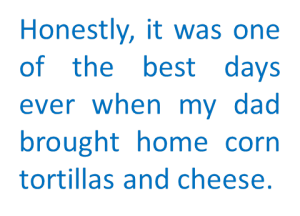By: Yim Fan Yan
One thing I take for granted from time to time is the privilege of having grown up multi-culturally in metropolitan Los Angeles. My family moved to the US in the late 1980s and eventually made their way to southern California. There, we were exposed to the many different—racially, ethnically, culturally, linguistically, politically, religiously, socioeconomically different—communities that coexist to make Los Angeles whole. My parents continued to speak their native languages and celebrate important traditions at home, but they also began to assimilate and adopt various seemingly mundane customs that were pivotal to their experiences  as Chinese Americans. They had no choice but to do so, partly because they had school-aged children, my brother and me, who attended public school with other neighborhood kids. What my brother and I experienced were “normal” to us, but imagine having your kids coming home singing songs in other languages, having friends with whom you couldn’t communicate, and asking for things that you had no idea existed let alone know how to provide. Honestly, it was one of the best days ever when my dad brought home corn tortillas and cheese. The day that my mom allowed me to plop a jar of mayonnaise into our grocery cart comes in at a close second. Bless my parents—my brother and I, the brats that we were, begrudgingly participated in their traditional rituals and holidays and demanded that they not only participate in, but also fund, ours. So, we had a sort of ongoing cultural exchange within the home. American and pseudo-American holidays, including Thanksgiving, were one of these trades.
as Chinese Americans. They had no choice but to do so, partly because they had school-aged children, my brother and me, who attended public school with other neighborhood kids. What my brother and I experienced were “normal” to us, but imagine having your kids coming home singing songs in other languages, having friends with whom you couldn’t communicate, and asking for things that you had no idea existed let alone know how to provide. Honestly, it was one of the best days ever when my dad brought home corn tortillas and cheese. The day that my mom allowed me to plop a jar of mayonnaise into our grocery cart comes in at a close second. Bless my parents—my brother and I, the brats that we were, begrudgingly participated in their traditional rituals and holidays and demanded that they not only participate in, but also fund, ours. So, we had a sort of ongoing cultural exchange within the home. American and pseudo-American holidays, including Thanksgiving, were one of these trades.
In elementary school, we were served a diluted version of historical events that led to the establishment of Thanksgiving the holiday, and then promptly inundated with arts and crafts assignments that involved construction paper, pumpkins, turkeys, cornucopias, and Pilgrims. Thanksgiving was something my brother and I celebrated with people at school, church, or a volunteer organization, but never at home. We did, however, watch television specials that featured families who would gather over a humongous Thanksgiving feast, fight over ridiculously dramatic nonsense, and then make up and have dessert. Oddly enough, I wanted that specific experience so badly that one year, I coerced my family into celebrating Thanksgiving with me—huge meal and all with just enough gossip to deem it an official family gathering. It was a hectic one-person show, but no one complained. How could they when the results of my efforts yielded moist turkey, smooth gravy, mashed potatoes, green beans, cranberry sauce, a healthy salad, homemade yeast rolls with butter, and pumpkin pie (and let’s not forget the rice for my dad)? Our family’s very first Thanksgiving was a success!
Although learning and analyzing different accounts of American history and witnessing the eventual commercialization of Thanksgiving has taken away some of that naiveté I possessed back then, it’s hard to refuse a couple of days off to gather with loved ones and enjoy a fabulously prepared meal. My family still gets together this way whenever I’m in town this time of year, but it’s a potluck scenario more often than not. These days Thanksgiving means extra time to catch up on sleep and work on final projects (fellow students: am I right, or am I right???). I’m not flying to LA this year because of said projects, but I still plan on devoting a part of break to appreciate and cook, eat and drink with those who make New Jersey a home away from home, which brings me to…pie!

(www.hilariousgifs.com)
According to the American Pie Council, pie has been around since the time of the ancient Egyptians. Admittedly pie isn’t my favorite dessert, but it’s arguably one of the most fun ones to create. There’s something wonderfully paradoxical about making pie. A whole lot of order and precision is required to make this dessert that personifies a beautiful hot mess. Depending on the pie, it can be simultaneously golden, crispy, gooey, soft, sweet, savory, and just about every other adjective out there. Add ice cream, whipped cream, or even gravy in this case, to the mix, or switch up the pie recipe as Jay Gilbert did here, and this dessert’s complexity rating soars. It is quite possibly the perfect topic for a short-answer question on a sensory analysis or food chemistry exam, but don’t give my professors any ideas. 🙂
I’m still undecided on which pie recipe to use this year. Aside from devouring the pie once it’s out of the oven and cooled, I think the nerdy side of me is actually most excited about choosing which starch, if any at all, to use in the pie filling. Carbohydrates labs and posts like Diana’s on starch gelatinization have taught me to mind my heat and moisture when attempting to get starches to do what we want, lest we cause the starch granules to burst too quickly, so technique will definitely be a focus of mine. Help me out here, food science folks. I’d probably want to use one that’s higher in amylopectin content and exhibits freeze/thaw stability (if I plan not to eat the whole pie), right? Corn, potato, tapioca, and arrowroot starches are available at grocery stores near me.
In any case, no matter what type of starch/pie ends up at the table this year, I’m thankful that my family and I have been able to use food as a medium to share with each other a slice of our unique American experiences. Side note: I’m also thankful for innovative product and recipe development teams, because who doesn’t want to inject Thanksgiving flavors into everything? Thanksgiving-themed ice cream, here I come.
What about you? How have you made Thanksgiving your own? Have you ever foodsci’ed your dish to make it even more magically delicious? Yes, I just used “foodsci” as a verb.
References
Damodaran, S.; Parkin, K.; Fennema, Fennema’s Food Chemistry, 4th ed. CRC Press Taylor & Francis Group: New York, 2008.
Vaclavik, V.; Christian, E. Essentials of Food Science, 3rd ed. Springer: New York, 2008.






Leave a Reply